#no pattern just rectangles and HSTs
Explore tagged Tumblr posts
Text
Progress Pride Flag Quilt Block Pattern & Tutorial
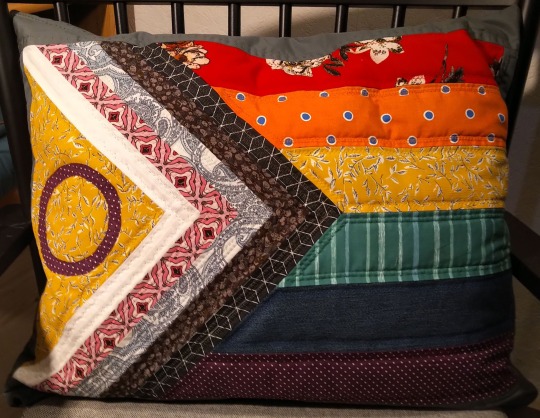
Don't you just love the flag of our people? Do you have an inner grandma that years to make stuff? Do you want to combine these two things and make a queer quilt?
Well, I've got you.
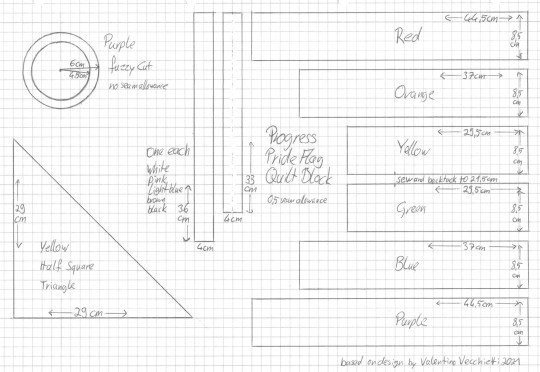
Behold the pattern! And my lack of graphic skills, so I drew it on paper!
Basically it's a bunch of rectangles, one half square triangle and a fuzzy cut circle. I don't know shit about quilting and I was able to come up with it. Why centimeter, you ask? Because I'm German and that's what I'm familiar with. Why weird measurements and not jelly rolls and layer cakes and stuff? Because I'm German and quilting is not really a thing here.
Onto the tutorial!
You'll need:
A scrap of fabric of red, orange, yellow, green, blue, purple, black, brown, light blue, pink, white each
additional fabric for the border
Cutting mat, quilting ruler, roll cutter
sewing machine
thread
pins
double sided interfacing
iron and ironing board
fabric sheers
compasses
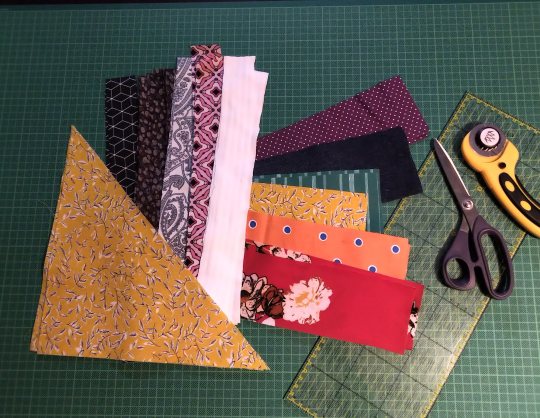
Step 1: Cut everything. Duh. We'll take care of the circle later, don't worry about that now. The half square triangle is exactly what it sounds like. A square and then you cut it diagonally. That's why I didn't give the length of the hypotenuse.
(Note: I'm making two blocks at the same time, that's why there's so much fabric. Also this is a middle of the night project, hence the lighting.)
I'm using all kinds of different fabrics, different weights and drapes, some stretchy, some transparent, so I needed to interface some of them.
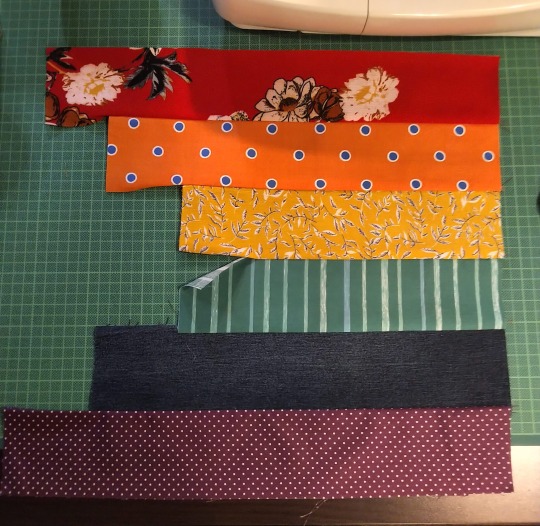
Step 2: Sew the rainbow together. 0,5cm seam allowance on everything, that's exactly the edge of the foot on your machine. Double and triple check that everything is facing the right direction before sewing. The seam of yellow and green does not get sewn fully, only 21,5 cm! That's important later! Also backtack there. Don't forget to iron.
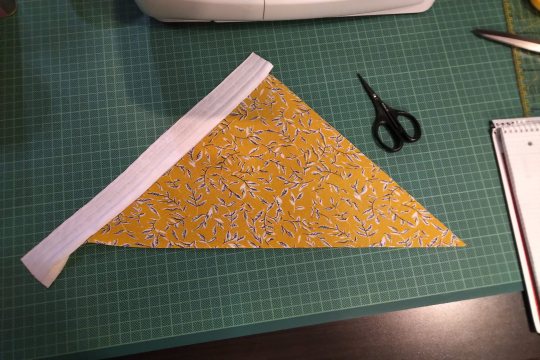
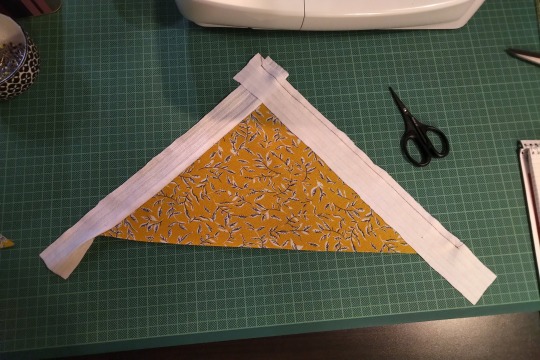
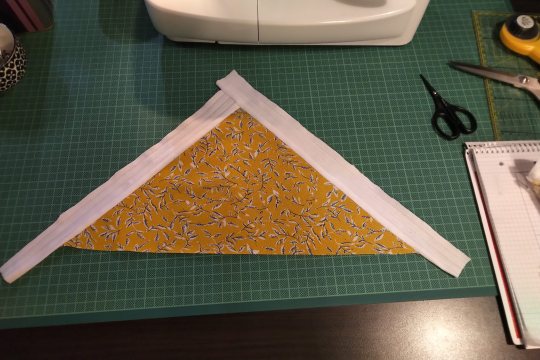
Step 3: Sew the strips to the half square triangle. For this you have to switch between the sewing machine and the ironing board constantly. Attach the shorter strip diretly to one side of the HST, iron it open. The second strip of the same colour gets attatched to the other side of the HST and the first strip. Look at the pictures closely if you're unsure how that works. Also the strips are longer than the triangle. We'll square that up later.
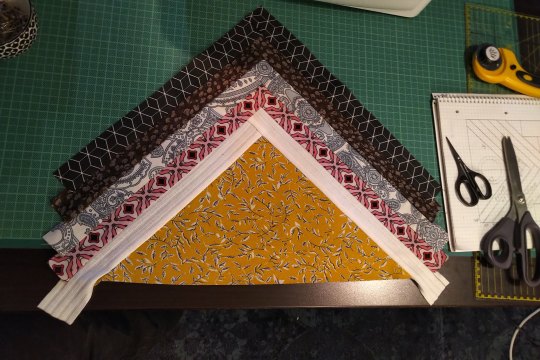
All strips attatched will look like this. See how the two strips meet at the tip!

Step 4: Cut the rainbow part to size. The length between yellow and green is 22cm long. The shorter seam from before plus some seam allowance. The outsides of red and purple are 44,5cm long. These two points are the beginning and end of your cutting line. You will cut a little triangle from every single colour. Do this slowly and carefully. Maybe your fabrics have stretched a bit (mine did). Don't worry, it will be ok.
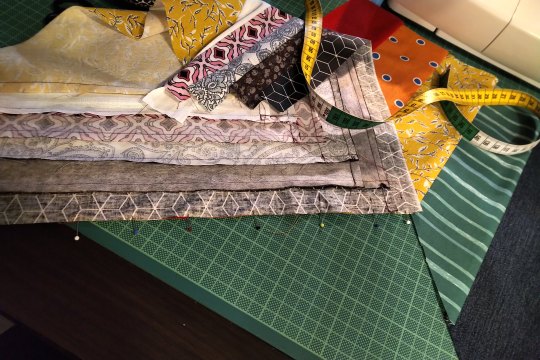
Step 5: The Y seam, part one. Y seams are tricky, but there's only one for this block. So put your strips part on your rainbow part and line them up so that the tip of the strip part overhangs the seam between yellow and green by about half a centimeter. Remember that it's not about the edges of the fabric, but where the seam will be. But don't sew all the way! Leave 0,5cm at the tip!
You can also mark on your strip piece two lines 0,5cm from the edges of the black. They should form a little square at the tip. There they meet is where the actual tip on the finished block will be. So place this spot directly on the seem between yellow and green and only sew right up to it. Not beyond.
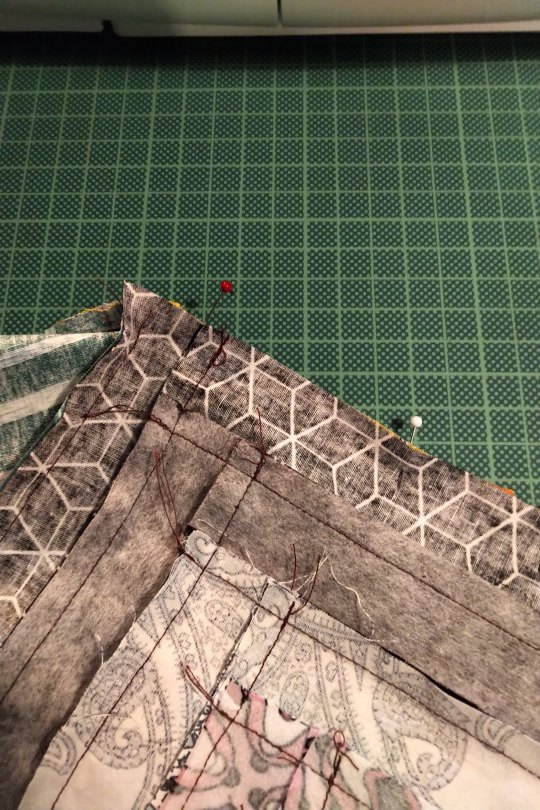
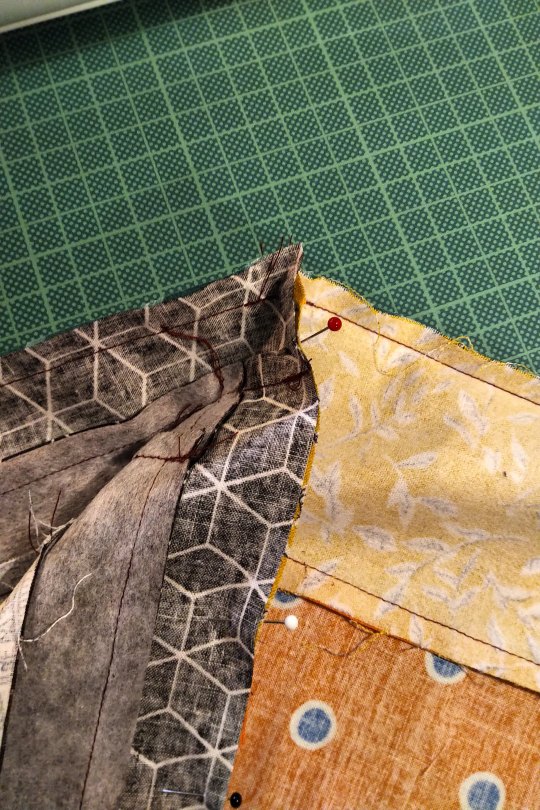
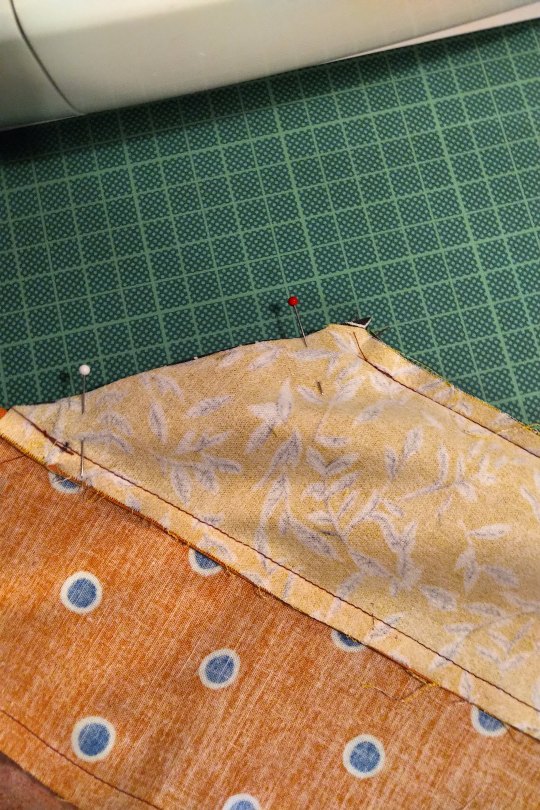
Step 6: The Y seam, part two. Now, fold both the rainbow part and the strips part in half and if you've done the last step correctly, the remaining two edges will allign. Pin and sew.
I can't explain it better than I've done here, I'm sure there are tutorias out there. Good luck!
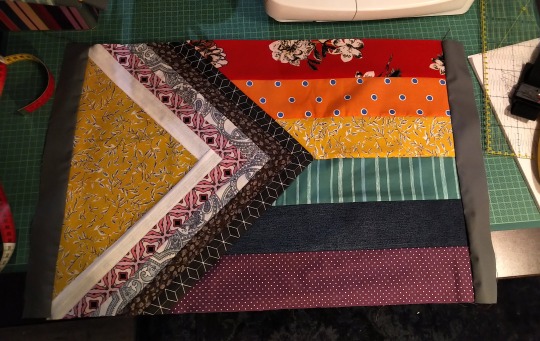
Step 7: Square up. Iron your block to that everything is nice and straight and flat. Then use the fabric edges of the red and purple to cut the remaining ends of the strips. Use the HST to cut the white. Be careful, the long side of the triangle is on the bias and likely stretched a bit.
I already added borders here. I'm making a pillow case.
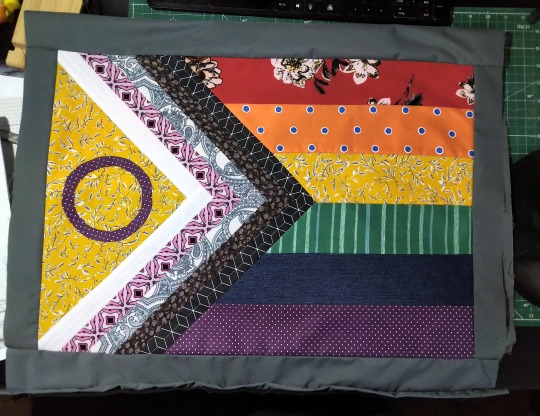
Step 8: Fuzzy cut and raw edge applique. Double sided iron on interfacing is essentially double sided tape. It has two types of glue, one gets activated by 2 seconds of heat, the other by 5 or so (depends on the product). The second side is also covered with a paper that needs to be removed before the second gluing. Read the instructions of the product you are using!
Use your compasses to draw a circle on the protective paper side of the interfacing. It's actually two circles from the same middle point, see pattern. Cut it out roughly. Then place it with the rougher side on the backside of your purple fabric and iron for 2 seconds on middle heat. If you've just ironed your fabric before and the ironing board is still hot, wait for it to cool down. Also let the fabric cool down after applying. Then cut out your circle. The interfacing will have stiffened the fabric, so that shouldn't be a problem. Then remove the protective paper, place the circle on the yellow triangle where you want it and iron for 5 seconds. Let cool.
And you're done! The applique at this point is only secured with the interfacing, but it should hold fairly well. The quilting will secure it further.
And that's it. BTW, did you know that this design was made by Valentino Vecchietti for Intersex Equality Rights UK in 2021? Now you do. Happy quilting!
#lgbt+#lgbtq+#lgbtq community#pride flag#progress pride flag#valentino vecchietti#quilting#quilt#quilt block#quilt pattern#quilt tutorial#sewing#sewing machine#sewing tutorial#sewing pattern
284 notes
·
View notes
Photo

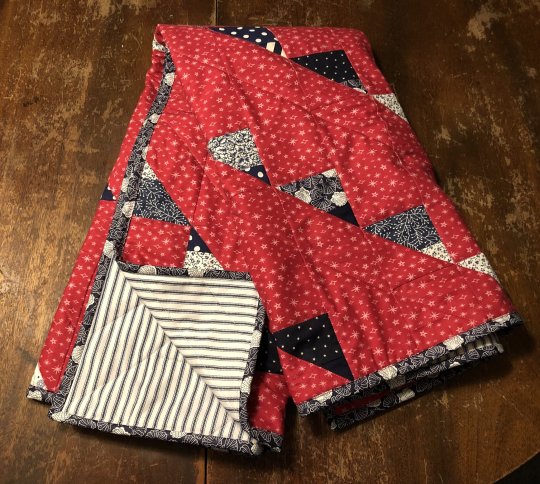
Quilt finish! This is made of the off-cuts of a larger quilt that’s going to be sandwiched next but the relatively small size and the fact that I had backing material readily available meant it got done first. At only 3′x3′, it’s one of the smallest quilts I’ve done (that weren’t pillows).
This is the bonus quilt that’s part of Quilty Love’s Happy Stripes pattern, although I simplified it a bit by using rectangles between each HST instead of two squares because then I didn’t have to do as much seam matching and frankly it was just less sewing thanks to a bit of math.
This one doesn’t have a home at this point. Not sure if I’m going to offer it up to friends or keep it in reserve for future babies. Although I’m getting old enough that most of my friends are done with babies until the grandkids start arriving.
4 notes
·
View notes
Text
Astronomers Still Don’t Know What It Will Look Like When The Sun Dies
https://sciencespies.com/news/astronomers-still-dont-know-what-it-will-look-like-when-the-sun-dies/
Astronomers Still Don’t Know What It Will Look Like When The Sun Dies


Around 7 billion years from now, our Sun’s life will end.
As the Sun becomes a true red giant, the Earth itself may be swallowed or engulfed, but will … [+] definitely be roasted as never before. The Sun’s outer layers will swell to more than 100 times their present diameter, but the exact details of its evolution, and how those changes will affect the orbits of the planets, still have large uncertainties in them.
WIKIMEDIA COMMONS/FSGREGS
Becoming a red giant, it eventually exhausts its core fuel.
In the early stages of a preplanetary nebula, hydrogen gas is expelled in a roughly spherical … [+] fashion, before transitioning to a bipolar shape. The spiral pattern is thought to emerge if the star ejecting the matter is part of a binary system, which is not uncommon. Approximately 50% of the stars in the Universe are parts of multi-star systems.
ESA/NASA & R. Sahai
Gravitation overcomes the decreased radiation, expelling the tenuous outer layers.
The Egg Nebula, as imaged here by Hubble, is a preplanetary nebula, as its outer layers have not yet … [+] been heated to sufficient temperatures by the central, contracting star. This will evolve into a planetary nebula when fusion in the outer layers of the central white dwarf ionizes and more fully illuminates the surrounding ejecta.
NASA
The hot, contracting interior — forming a white dwarf — ionizes and illuminates the ejecta.
The rotten egg nebula, at lower right (and shown in detail in the inset box, as imaged by Hubble) is … [+] a preplanetary nebula that’s part of a larger star cluster that also contains a full-blown planetary nebula, at the upper left. Whereas planetary nebulae are emission nebula, preplanetary nebulae only reflect the light from their central star.
Adam Block/Mount Lemmon SkyCenter/University of Arizona (main); ESA/Hubble & NASA Acknowledgement: Judy Schmidt (inset)
These short-lived planetary nebulae shine for only tens of thousands of years before fading away.
The Dumbbell Nebula, as imaged here through an 8″ amateur telescope, was the first planetary nebula … [+] ever discovered: by Charles Messier in 1764. The shells of gas are slowly expanding and their definition remains constant over time, typical for a planetary nebula.
Mike Durkin; madmiked/flickr
All stars born with 40%-to-800% the Sun’s mass experience similar fates.
The (modern) Morgan–Keenan spectral classification system, with the temperature range of each star … [+] class shown above it, in kelvin. Our Sun is a G-class star, producing light with an effective temperature of around 5800 K and a brightness of 1 solar luminosity. Stars can be as low in mass as 8% the mass of our Sun, where they’ll burn with ~0.01% our Sun’s brightness and live for more than 1000 times as long, but they can also rise to hundreds of times our Sun’s mass, with millions of times our Sun’s luminosity and lifetimes of just a few million years. The most massive O-and-B-stars will go supernova, while the low-mass M-class stars will never fuse helium in their cores. All others, comprising about ~20% of all stars, will die in a planetary nebula/white dwarf combination, like our Sun.
Wikimedia Commons user LucasVB, additions by E. Siegel
Only ~3000 planetary nebulae exist among the Milky Way’s ~400 billion stars.
The famed planetary nebula NGC 7293, the Helix Nebula, and its central white dwarf, as imaged by … [+] Hubble. The central white dwarf is responsible for illuminating the outer layers, as the hot, ultraviolet radiation ionizes the outer material, which then emits light when the electrons fall back onto the ionized nuclei and cascade down the various energy levels.
NASA, ESA, and C.R. O’Dell (Vanderbilt University)
And yet, there’s a tremendous mystery surrounding them.
Nitrogen, hydrogen and oxygen are highlighted in the planetary nebula above, known as the Hourglass … [+] Nebula for its distinctive shape. The assigned colors distinctly show the locations of the various elements, which are segregated from one another. Complex molecules, including fullerenes containing 60 carbon atoms apiece, have been found in various planetary nebulae (and other locations) in space.
NASA/HST/WFPC2; R Sahai and J Trauger (JPL)
Somehow, 80% of them show evidence of directionality.
The Twin Jet nebula, shown here, is a stunning example of a bipolar nebula, which is thought to … [+] originate from either a rapidly rotating star, or a star that’s part of a binary system when it dies. We’re still working to understand exactly how our Sun will appear when it becomes a planetary nebula in the distant future.
ESA, Hubble & NASA, Acknowledgement: Judy Schmidt
Many are bipolar nebulae, with two opposing lobes of ejecta.
This planetary nebula may be known as the ‘Butterfly Nebula’, but in reality it’s hot, ionized … [+] luminous gas blown off in the death throes of a dying star, and illuminated by the hot, white dwarf this dying star leaves behind. Our Sun is likely in for a similar fate at the end of its red giant, helium-burning phase.
STScI / NASA, ESA, and the Hubble SM4 ERO Team
Others display spiral structures within them.
The Red Rectangle Nebula, so called because of its red color and unique rectangular shape, is a … [+] preplanetary nebula in the Monoceros constellation. It is part of a binary star system, where one member is ejecting the hydrogen gas in the post-AGB phase. This system will someday evolve, but has not yet evolved, into a full fledged planetary nebula.
ESA/Hubble & NASA
Still others are sculpted with odd, irregular shapes.
Normally, a planetary nebula will appear similar to the Cat’s Eye Nebula, shown here. A central core … [+] of expanding gas is lit up brightly by the central white dwarf, while the diffuse outer regions continue to expand, illuminated far more faintly. This is in contrast to the Stingray Nebula, which appears to be contracting.
Nordic Optical Telescope and Romano Corradi / Wikimedia Commons / CC BY-SA 3.0
Merely 20% of planetary nebulae appear spherically symmetric: expected for singlet, Sun-like stars.
When seen from a certain orientation, this donut-shaped nebula, known as the Ring Nebula, provides a … [+] possible example of what our Sun might become approximately 7 billion years from now, when it dies in a planetary nebula. We expect spherical symmetry from singlet stars, but the number of spherical planetary nebulae is lower than we expect.
NASA, ESA, and C. Robert O’Dell, Vanderbilt University
This is puzzling: 50% of all stars are singlets like our Sun.
This image from ESO’s Very Large Telescope shows the glowing green planetary nebula IC 1295 … [+] surrounding a dim and dying star located about 3300 light-years away. The green color arises from emission line transitions in the ionized gas surrounding the dim, dying star. The spherical shape, however, is a relative rarity.
ESO / FORS instrument
Why, then, are only 20% of planetary nebulae spherically symmetric?
The red spiders nebula, shown here, has ripples and shock waves throughout its gas, due to the … [+] ultra-high temperature of its parent star: one of the hottest stars to form a planetary nebula in the known Universe. It is not yet known why this nebula has the morphology that it does, rather than being spherically symmetric.
ESA & Garrelt Mellema, Leiden University, the Netherlands
Perhaps large planets also carve irregular shapes.
This fiery swirl, known colloquially as the Eye of Sauron Nebula, is actually a planetary nebula … [+] known as ESO 456-67. The different gases and opacities translate into this stunning, multiwavelength view that looks right at you from across the galaxy.
ESA/Hubble and NASA / Acknowledgment: Jean-Christophe Lambry
Perhaps magnetic fields cause asymmetrical nebulae around singlet stars.
The planetary nebula shown here, NGC 2440, shows a large amount of ejected material blown off during … [+] the final stages of a dying red giant star’s life. The uncertainties in modeling the evolution of our Sun beyond the main sequence phase are too great to definitively draw conclusions about the survivability of planet Earth, or of the shape of our Sun’s eventual planetary nebula.
Hubble Heritage Team, ESA/NASA Hubble, and Howard Bond (STScI) and Robin Ciardullo (Penn State)
Or perhaps the more massive stars, shorter-lived and rapidly spinning, bias our statistics.
The Medusa Nebula, shown here, is faint, diffuse, and shows a complex structure indicative of its … [+] old age. Planetary Nebulae only persist for about 10,000 to 20,000 years, and this one is apparently nearing the end of its life. As the gas becomes neutral or too diffuse to shine and the central white dwarf cools, the nebula fades away entirely.
Jschulman555 / Wikimedia Commons / Mt. Lemmon Skycenter
Despite our knowledge, we still cannot predict the Sun’s eventual nebular structure.
The planetary nebula NGC 6369’s blue-green ring marks the location where energetic ultraviolet light … [+] has stripped electrons from oxygen atoms in the gas. Our Sun, being a single star that rotates on the slow end of stars, is very likely going to wind up looking akin to this nebula after perhaps another 7 billion years.
NASA and The Hubble Heritage Team (STScI/AURA)
Mostly Mute Monday tells an astronomical story in images, visuals, and no more than 200 words. Talk less; smile more.
#News
0 notes